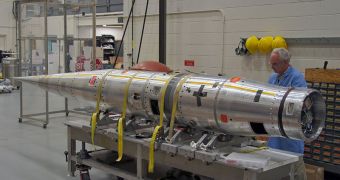On July 21, NASA officials plan to launch the Inflatable Reentry Vehicle Experiment (IRVE-3), a machine that will be used to test a new type of technology the American space agency plans to use in future missions. The vehicle will basically be testing an inflatable heat shield.
Obtaining such a capability would help NASA explore other worlds safely, but it will also enable it to boost the safety of missions returning to Earth as well. IRVE-3 is currently a unique experiment.
At this point, the machine is being prepared for launch, at both the NASA Wallops Flight Facility, in Virginia, and the NASA Langley Research Center, in Virginia. Though a clear takeoff date has yet to be established, agency officials want to launch the vehicle as soon as July 21.
The test article will be launched into space aboard a three-stage, Black Brant XI sounding rocket. The entire effort is being developed under the auspices of the NASA Space Technology Program's Game Changing Development Program.
According to officials, IRVE-3 is part of the Hypersonic Inflatable Aerodynamic Decelerator (HIAD) project. The entire payload consists of an inflation system, steering mechanisms, telemetry equipment and camera gear.
“We have developed a 10-foot (3 meters) diameter heat shield that we are packing – uninflated – into the 22-inch (56 centimeters) diameter nose cone of a three-stage Black Brant XI sounding rocket,” explains the chief engineer of the IRVE-3 program, Robert Dillman.
The actual heat shield is made up of a series of inflatable rings, which look like a mushroom of some kind when inflated. A high-tech thermal protection system blankets these rings, to protect them from the fierce temperatures experienced during atmospheric reentry.
“Packing [the heat shield] actually turns out to be quite a challenge. One reason is because the IRVE-3 thermal protection system has this insulating layer of pyrogel – an aerogel – that is largely air. That makes it very difficult to compress. It's like trying to compress a sponge,” says Neil Cheatwood.
He holds an appointment as the principal investigator for both IRVE-3 and HIAD. The expert explains that spacecraft reentering Earth's dense atmosphere can experience temperatures of up to 1,010 degrees Celsius (1,850ºF). Overall, the IRVE-3 experiment weighs just 308 kilograms (680 pounds).
If successful, NASA could apply this technology to manned missions meant to explore other worlds, as well as to robotic spacecraft that try to land on other celestial bodies.

 14 DAY TRIAL //
14 DAY TRIAL //